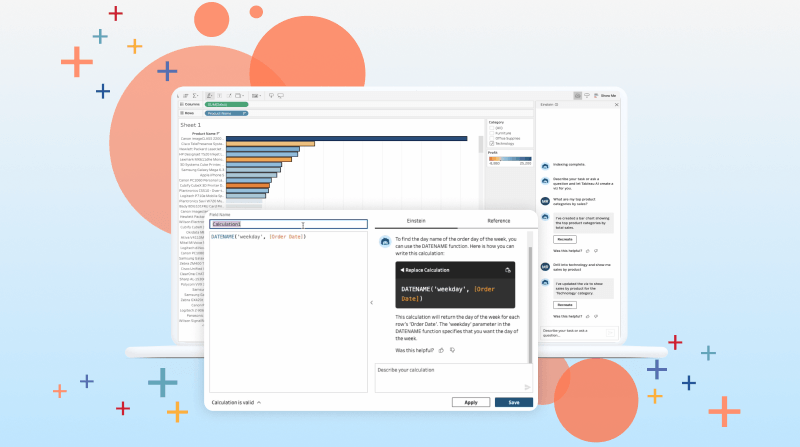Salesforce Inc. has rolled out data visualization and AI infrastructure improvements for its Tableau Software platform today that increase the usability of its product for data analysts and expand its scalability for artificial intelligence.
The company noted that according to its own research, only 30% of workers use data to make business decisions. Tableau is a visual analytics platform designed to allow people and organizations to make data understandable and solve problems collaboratively using AI and machine learning. On the AI side, Salesforce surveyed more than 1,000 information technology leaders and more than 81% said they felt the need to implement AI in their organizations, but 59% said they didn’t have a proper data strategy.
“These two things go together,” said Elizabeth Maxson, Tableau’s chief marketing officer. “You’ve heard all this before: Your AI strategy is only as good as your data strategy. To us, it’s about more than just having a data strategy it’s about a data culture.”
New infrastructure to support AI data
As AI becomes a larger part of every workflow, data and the support of IT scalability have followed behind as a challenge. To support IT teams, Tableau announced that the platform will integrate with Hyperforce, Salesforce’s public cloud infrastructure with data residency running on a global scale. With the addition of Hyperforce, Tableau Cloud users will have access to their data quickly from anywhere in the world with a multitude of different data centers.
This move will help support the recent launch of Einstein Copilot for Tableau, Salesforce’s generative AI now available in beta as of early April. Using the tool, users can automate data transformations with step-by-step suggestions using conversational prompts for data analysis and single clicks. With Tableau Catalog the chatbot can generate descriptions of data and data sources to make short work of complex or tedious reports by assembling easy-to-understand summaries.
Tableau Pulse, announced during last year’s conference, is now generally available. It brings generative AI into data analysis for personalized insights, has received a few improvements as well. Updates include a new “Ask” Q&A that will help analysts explore metrics within different communication platforms such as Slack, email or on mobile devices, so marketers don’t need to switch applications. It also now comes with proactive insights for metrics, allowing it to catch trends as they’re happening, and metric goals to help users compare progress based on benchmarks or targets.
“Customers must consider a variety of factors when selecting data and analytics technologies,” said Chandana Gopal of IDC Research Inc. “They need to leverage modern tools powered by AI or they’ll fall behind their competitors. But they also need systems that are easy to manage at scale. They need confidence that their platform of choice is supported by talent in the market to build out the staffing and processes required for a data-driven business.”
Tableau product improvements
Tableau is getting improvements to quality-of-life chart building and presentations that use data, such as Viz Extensions. These extensions will help designers and developers create complex diagrams by encapsulating complex workflows and visual libraries for creating graphics quickly and easily. For example, a new Snakey extension allows an analyst to create a snakey graph chart, which is a visualization that produces a flowing snake-like graphic, in a few clicks to avoid the need to write complex code and calculations.
Other frequent challenges faced by analysts for data visualization include building from multiple fact tables that involve shared dimensions and other complex data, which Tableau can now work with. The platform has also been updated with composable data sources that can be used without changing the underlying model.
For example, using these new capabilities, a data analyst can create a single unifying model that can handle dozens of data visualizations with very little new code. A retailer could combine incoming shipments, worker data on shifts and time off, internet of things data based on tags from the back room to the display cases, and shipments from suppliers in a single model.
Tableau Desktop Public Edition, a free platform that anyone can use to create and publish data visualizations online, is getting an update that will allow users to save their work locally. In the past, users needed to publish their work for everyone to see, no matter what they were working on. The mission of Tableau Public Edition is to provide a public visualization resource for data learners, enthusiasts and nonprofit users to explore data that matters.
Image: Tableau
Your vote of support is important to us and it helps us keep the content FREE.
One click below supports our mission to provide free, deep, and relevant content.
Join our community on YouTube
Join the community that includes more than 15,000 #CubeAlumni experts, including Amazon.com CEO Andy Jassy, Dell Technologies founder and CEO Michael Dell, Intel CEO Pat Gelsinger, and many more luminaries and experts.
THANK YOU
Source link
lol

